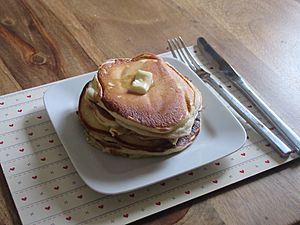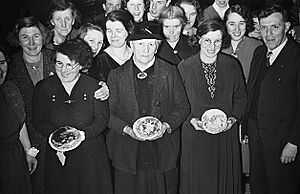Crempog facts for kids

Crempog, made using the Anglesey recipe
|
|
| Alternative names | Ffroes |
|---|---|
| Type | Pancake |
| Place of origin | Wales, United Kingdom |
| Main ingredients | batter |
Crempog (say: KREM-pog) is a yummy Welsh pancake. It's made with flour, buttermilk, eggs, vinegar, and salted butter. People traditionally cook crempog on special flat stones called bakestones or on griddles. It's one of the oldest recipes from Wales!
You might also hear crempog called ffroes, pancos, or cramoth. They are usually served in a tall stack, with lots of butter spread on each pancake. Crempog is often a special treat for celebrations in Wales, like Shrove Tuesday (Pancake Day) and birthdays.
Contents
What's in a Name?
The word "Crempog" comes from the Welsh language. It's quite similar to the Breton word krampouezh, which also means a type of pancake. Both Welsh and Breton are Celtic languages, so it's not surprising they share similar words. However, Breton krampouezh are usually thinner, more like a Crêpe, while crempog are thicker.
The English word crumpet might even come from crempog or the Cornish word krampoeth.
A Taste of History
Learning about old Welsh food can be tricky because not much was written down. We mostly learn from old stories and things found by archaeologists. For a long time, people in Wales used a special cooking stone called a bakestone (or maen in Welsh). This was a big, flat, round stone that could be carried around.
Later, metal plates called gradell (griddles) replaced the stone bakestones. These metal griddles were even mentioned in the old Laws of Hywel Dda from the 1200s! Bakestones were very common in Welsh homes, from farms to fancy houses. People used them to cook flatbreads. Early bakestones were placed on a tripod over an open fire.
By the early 1900s, many Welsh kitchens had built-in ovens that burned wood and coal. But people still used bakestones! Big ovens were often heated only once a week to bake enough bread and cakes for the whole family. For daily meals, people would cook things over the open fireplace using the bakestone. Popular foods made this way included cacen radell (griddle cake), bara crai' (unleavened bread), [[Welsh cake|cacen gri]] (speckled cakes), and, of course, crempog.
Even though we don't have the very first crempog recipe written down, the ingredients are simple and were always easy to find in Wales. This tells us that crempog has a very long history. It's a dish that has stayed popular in Welsh cooking because it was easy to make.
Crempog is also linked to special celebrations. It was often served on Shrove Tuesday (Pancake Day) across Wales. In South Wales, crempog was also a birthday treat. People would stack the pancakes high and cut them like a cake!
How to Make Crempog
Making a classic crempog involves a few steps:
- First, butter is melted in warm buttermilk.
- This buttery buttermilk is then poured into a pile of flour and mixed well.
- This first mixture needs to sit for a few hours.
- Next, a second mixture is made with sugar, bicarbonate of soda (baking soda), vinegar, and beaten eggs.
- Finally, both mixtures are combined to create a smooth, thick batter.
The thick batter is then poured onto a hot bakestone or griddle over a medium heat. The crempog cooks until it's golden brown on both sides. Then, it's served in a stack, with butter spread on each warm pancake. Delicious!
Different Kinds of Crempog
Just like many traditional foods, there isn't just one way to make crempog.
- In places like Anglesey and Caernarfonshire, people made crempog furum, which used yeast, or crempug wen, which used finer, refined flour.
- These fancier pancakes were usually for the family. Servants might have eaten crempog surgeirch or bara bwff, which were pancakes made with oatmeal.
Crempog also had different names depending on where you were in Wales:
- Crempog was most common in North Wales.
- In parts of Carmarthenshire and Glamorgan, they were called cramwythen (or cramoth for one).
- Other parts of Glamorgan called them ffrosen (or ffroes for many).
- In Cardiganshire, they were known as poncagen (or poncagau).
- Some areas in both Cardiganshire and Carmarthenshire called them pancosen.
The ffroes from Glamorgan are quite similar to Scottish pancakes (also called drop scones). It's thought that Scottish workers might have brought this style of pancake to South Wales when they came to work in the coal mines. But stacking them high and covering them in butter is a true Welsh tradition!
Images for kids



